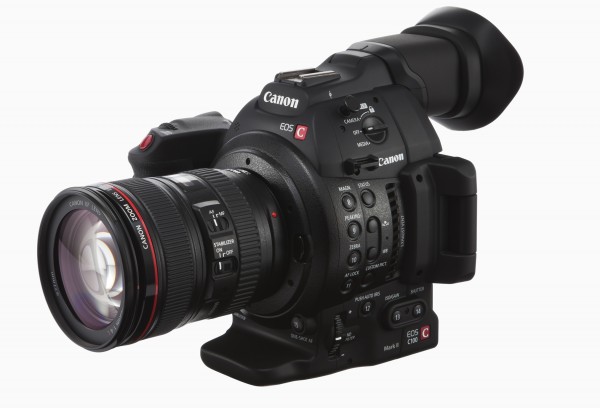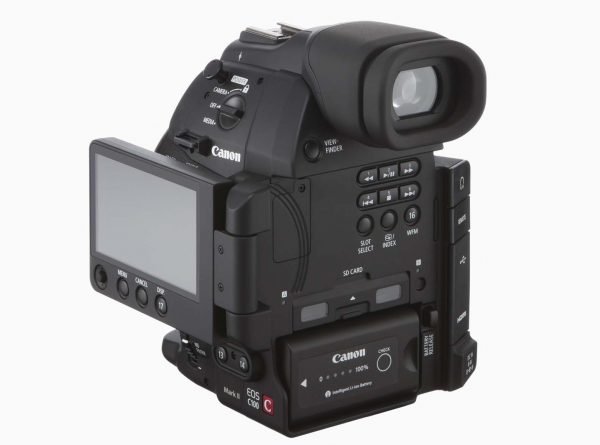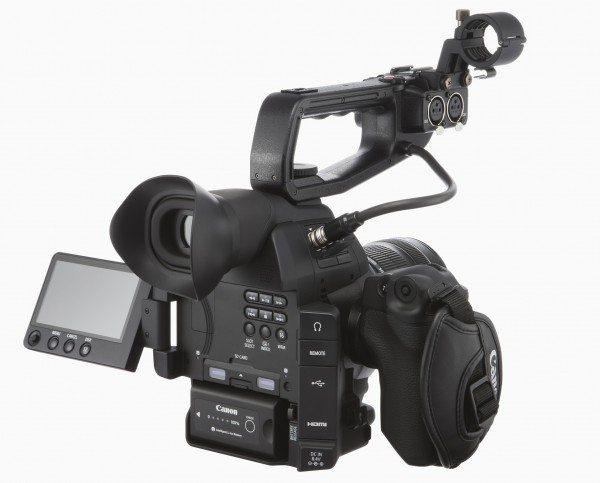By site editor Dan Chung:

Canon have today updated the popular C100 with a mark II version that has several useful feature enhancements, but no change in overall design.
The Dual Pixel CMOS AF system that was an optional upgrade to the original C100 is now included by default on the new camera. For me this is a key feature that is useful for the kind of news and documentary shooting that I do. The original C100 only autofocussed in the centre of the frame. The mark II adds the ability for the camera to track an off centre subject with face detection – but it still lacks the touch screen focus of the 70D. This to me is a real missed opportunity and its a shame that the new camera can’t do something that a cheaper DSLR can. Achieving a relatively simple focus transition for a static off-centre subject will still be almost impossible to accomplish using Dual Pixel AF with the new camera.
The camera body remains nearly identical to its predecessor and for many shooters that will be no bad thing. The biggest improvements are an improved EVF that tilts and is twice as large as the first C100 – the original EVF was universally disliked for its poor resolution and visibility. The new one should really help when using the camera handheld. The rear screen gets an upgrade to – now it is a 3.5” OLED with better resolution.

There are now a line of controls on the rear screen itself which should make adjustment easier. Also the OLED screen actually folds all the way around so that it sits alongside the body. This can be useful during interviews, or when mounting the camera on a shoulder rig. These improvements mean that the C100 mark II should be much better to use in the field. The upside of keeping the design similar is that most rigging and accessories for the original C100 will likely fit it you are upgrading.
Audio is similar to the original. There is an included top handle with built-in XLRs that connects to the top of the camera. Canon have also included an internal mic on the body itself – similar to most DSLRs. This is useful for scratch audio if recording externally and helps if you are trying to use the camera in a stripped down setup – for example on a brushless gimbal or Steadicam.
The sensor is unchanged. Its the same Super35 CMOS as the now industry standard C300. That means great colours and low noise at high ISO.

Recording is to SD cards as before, but with the addition of 59.94fps recording to MP4 for slow motion. AVCHD internal recording is still locked to 24 Mbps at 60i, 50i, 24p, 25p, PF30, and PF24 in 4:2:0.
As with the original C100 you can output clean, uncompressed 4:2:2 video with timecode via HDMI for external recording using a recorder like the Atomos Ninja Star. This essentially takes the C100 image up into the same league as the more expensive C300. The HDMI output also has the ability to show the Canon Log LUT on an external HDMI monitor or EVF – which gives a good sense of what a graded image would look like when recording Canon Log in the camera. This is useful for monitoring but only if you are recording internally to SD card.
Why Canon can’t offer higher frame rates or 4K video in a camera at this price point is puzzling to me. Panasonic and Sony have both got models that do this at similar or cheaper prices. Canon are targeting the C100 mark II at the solo shooter, so I assume they are hoping that practical usability and autofocus technology are bigger draws for users than 4K or slomo – time will tell if that’s the case.
The camera will go on sale at the end of the year with a price of $5499 US.
Here is the info from Canon:
MELVILLE, N.Y., October 21, 2014 – Canon U.S.A. Inc., a leader in digital imaging solutions, announced today the Canon EOS C100 Mark II Digital Video Camera, the latest edition to the Canon Cinema EOS line of professional Super 35mm 8.3 megapixel CMOS cameras and the second-generation version of the popular Canon EOS C100 Digital Video Camera.
Designed for economical film and video productions such as documentary and remote broadcast crews, wedding and event coverage, indie film productions, as well as film schools and business and government users, the new EOS C100 Mark II Digital Video Camera, features advanced image processing, AVCHD and MP4 1920×1080/60p recording, uncompressed YCbCr output from HDMI, and many other new and enhanced capabilities for improved picture quality, operability, and convenient handling. Delivering a cinematic look with shallow depth of field and high sensitivity in low-light environments, the new EOS C100 Mark II camera weighs just 2.5 lbs. and is compatible with over 103 Canon EF Series lenses, including STM models which can deliver smooth and silent autofocus during filmmaking.
“Canon’s commitment to the advancement of tools for visual expression takes another major step forward with the introduction of the EOS C100 Mark II Digital Video Camera,” said Yuichi Ishizuka, president and COO of Canon U.S.A., Inc. “Drawing on input from Canon’s global community of Cinema EOS camera users and from digital filmmakers using Canon EF lenses – 100 million of which have now been produced worldwidei – the Company has added new capabilities to the EOS C100 Mark II from its predecessor that powerfully leverage our considerable expertise in optics, imaging, and digital signal processing. The result is an improved, affordable Super 35mm CMOS digital camera that is designed to provide outstanding HD image quality, operational performance, ergonomics, and workflow convenience.”
Design Enhancements
Optimized for one-person operation, the new EOS C100 Mark II camera has a mobile core design enabling users to choose their preferred style of shooting. The existing design has been enhanced to include a large-size detachable eyecup for the camera’s large 68-degree tilting 0.45-inch 1.23 megapixel color EVF (electronic viewfinder). Clearly marked red trigger buttons on the camera body, top handle, grip, and a built-in mono microphone on the camera body — for times when the top handle is not attached — can be used to capture basic sound for audio notation or as an aid to audio syncing during post.
Another major redesign of the new EOS C100 Mark II over its predecessor is an innovatively hinged 3.5-inch 1.23 megapixel OLED display panel, delivering 100 percent field-of-view coverage, wide color range support, and improved viewing even in bright sunshine. The new hinge design — which folds the panel shut when stowed, protecting the OLED surface — opens 180 degrees to reveal function keys and a joystick. The panel can open even further to 270 degrees to deploy against the side of the camera to provide monitoring for directors and other production personnel. Additional design improvements on the camera body include 17 assignable recessed function buttons, dual SD card slots with a transparent cover, and a simplified battery insertion and removal release.
Visual Expression
Previously available only as an optional upgrade for earlier Cinema EOS models, Dual Pixel CMOS AF is a standard feature on the new EOS C100 Mark II, providing enhanced autofocusing capability. The Dual Pixel CMOS AF technology helps provide smooth and consistent autofocus, so that focus transitions are natural looking and subjects can remain in focus even as they move off center. In addition, the compatibility of Dual Pixel CMOS AF with Canon EF autofocus lenses combines outstanding optical tools with a wide range of creative options. It’s ideal for shooting sports, weddings and many more productions where focus pulling by a single operator is not feasible, such as when the video camera is attached to steadicams or drones. The EOS C100 Mark II Digital Video Camera also includes Face-Detection AFii, a first in the Cinema EOS camera line, which utilizes contrast detection AF to maintain focus across most of the image plane, an advantage in one-person electronic news gathering (ENG) situations.
Imaging and Recording
Central to many of the new features of the new EOS C100 Mark II Digital Video Camera is its advanced Canon DIGIC DV4 image processor. The Canon DIGIC DV4 image processor separates the RGB output from the camera’s 8.3 Megapixel CMOS imager into three individual 8 megapixel signals (as opposed to 2MB in the EOS C100) for noticeably improved image quality. The Canon DIGIC DV4 processor also includes a new debayering algorithm to help minimize moir‚ and reduce video noise even at high ISO speeds. (high-sensitivity recording on the camera ranges from ISO 320 to 80,000).
Another important benefit of the Canon DIGIC DV4 processor is Full HD recording in both the high-quality professional format AVCHD or the popular web-friendly MP4 format at a variety of bit rates (up to 28 Mbps and 35 Mbps, respectively), resolutions, and frame rates (up to the smooth look of 59.94p) to suit practically any production need.iii For special-effect requirements, slow and fast motion MP4 recording at up to 1920×1080/60p can also be performed.
Users can choose from multiple formats that support MP4 or AVCHD to suit a wide variety of production, post, and output needs. The EOS C100 Mark II camera’s dual SD card slots can record in one or both formats simultaneouslyiv for back-up, or convert AVCHD and MP4 files into smaller MP4 files for web upload.v Extended clip times can be achieved by recording continuously from one card to the other without a break. In addition, a Data Import Utility application is included that can seamlessly join divided files to help reduce work during editing and to import video file data from an SD card inside the camera or a card reader.
As with the other cameras in Canon’s Cinema EOS line, the new EOS C100 Mark II Digital Video Camera includes Canon Log as a recording choice, providing maximum dynamic range for post-production color grading. New, however, is the addition of a built-in LUT (look-up table), enabling users to view the camera’s live video signal in Wide DR (dynamic range) or the BT.709 (TV standard) color space on the OLED or any external monitor connected to the camera’s locking HDMI® output (this feature can be turned off in the menu). Uncompressed video output (with time code data and 2:3 pull-down markers superimposed) can be output via HDMI to an external recorder.
Connectivity Innovations
The addition of wireless file-transfer capabilities further expands the versatility of the new EOS C100 Mark II camera for multiple production applications, including transferring time-critical news video or backing-up files. Utilizing dual 5 GHz and 2.4 GHz frequencies, the camera can transfer video files via FTP server for instant relay, or send MP4 video to the web browsers of laptops or tablets for viewing and storage (even on PC’s lacking playback software). Remote control of the camera is also enabled via a compatible smartphone, tablet, or laptop. The new EOS C100 Mark II Digital Video Camera also includes compatibility with the optional multi-functional Canon RC-V100 Remote Controller, which can be used to adjust image quality and other important operations from a distance, a handy feature for shooting from a jib arm, drone, or other inaccessible location.
In addition, the optional Canon GP-E2 EOS GPS Receiver can be connected to the EOS C100 Mark II Digital Video Camera using a USB cable to record location and time information during shooting, a helpful feature for editing and archiving.
Pricing and Availability
The Canon EOS C100 Mark II Digital Video Camera is scheduled to be available at the end of December 2014 for an estimated retail price of $5,499.00.





